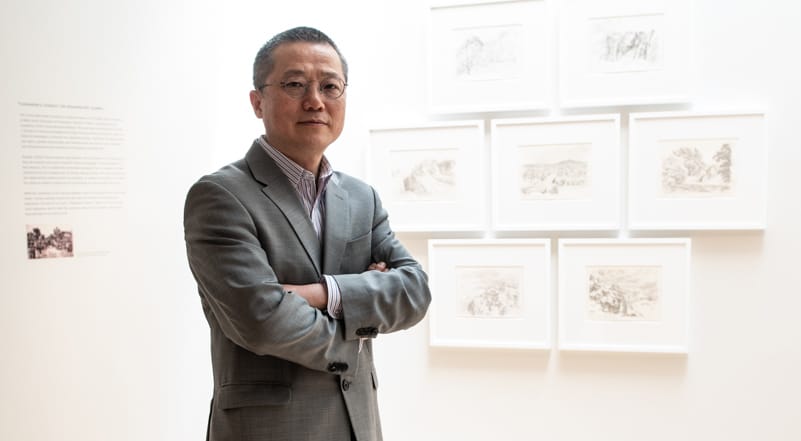
The Nevada Art Museum commemorated the 150th anniversary of the completion of the transcontinental railroad on Friday, May 10 with a panel discussion and ceremony remembering the contributions of Chinese laborers to the monumental effort. Artists Zhi Lin and Hung Liu joined Ann Wolfe, deputy director of the Museum, in a discussion of their work, a selection of which is currently on display at the museum.
Then the artists read the 800 known names of Chinese laborers who died building the railroad. Todd Green accompanied the reading on traditional Chinese instruments.
On May 10, 1869 the presidents of the Central Pacific Railroad (CPRR) and the Union Pacific Railroad met in Promontory, Utah to celebrate the meeting of their lines and linking of San Francisco and New York. Largely ceremonial, the event featured the driving of a “golden spike” into the final railroad tie. Photographer Andrew Russell immortalized the event in a picture that features railroad officials and selected employees raising a glass of champagne to celebrate their accomplishments.
There are no Chinese laborers in that photograph, an omission artist Zhi Lin articulates in his re-staging of the iconic Russell image. The multi-media video installation “‘Chinaman’s Chance’ on Promontory Summit” places the viewer behind the gathered crowd, looking over the shoulders of the revelers during their brief stop in Promontory.
“The photographers were hired by railway companies, mainly for propaganda, for advertisement,” Lin informed me during our pre-event interview. His “Chinaman’s Chance” revisits the ceremony from the other side of the tracks, placing the viewer behind the photographed scene, looking over the shoulders of the railroad executives. The canvas depicts the tracks, and a video plays atop that scene.
As the video portion ended, Lin drew my attention to the names of the Chinese workers inscribed in reddish pink on the stones spilling out from underneath the tracks. Those stones, the foundation for the tracks, document the workers who perished in the building of the railroad, and those names linger even after the train leaves the scene.

800 known names of deceased
Chinese laborers.
Running behind schedule and desperate to catch up, the CPRR hired the first 50 Chinese laborers in 1865. They proved to be hardworking and reliable, and the CPRR began hiring Chinese en masse. By 1866, almost 90% of the CPRR workforce, 12,000 of the 13,500 laborers, were Chinese. They worked around the clock, seven days a week for almost four years to finish the transcontinental railway. Chinese civic organizations retrieved the bodies of more than 1,200 deceased Chinese laborers, but the railroad maintained no records of their deaths.
Looking at “China Wall,” a watercolor of a rocky cliff and old railroad grade near Donner Summit, Lin points out the fitted-stone wall that once supported the tracks on their original course through the canyon. Several hundred feet below, in a pullout on old Highway 40, a plaque memorializes the construction of the Central Pacific.
“It’s much more intimate to walk on [the grade], to bike on it,” and yet there’s no plaque there, lamented Lin. “It is very important how we contextualize a location,” and, in that context, the walking trail is a missed opportunity. Lin calls on us to “remind our current generation how this country was built,” and to do so in ways that recall the whole context of that construction.
Having seen the plaque but having never read it, I looked it up online. It begins “Charles Crocker, construction chief of the Central Pacific Railroad (CPRR), contracted for a workforce…” The subject of the memorial is Crocker, not the laborers nor the structures it commemorates.
“The completion of the railroad—which linked the United States from east to west—is often celebrated as the grand achievement of America’s Manifest Destiny and the 19th-century rallying cry for westward expansion of the United States,” wrote Ann Wolfe in a press release for the event. “Zhi Lin provides us with an important opportunity to connect with forgotten stories, and to broaden our knowledge of our region’s history.”
An exhibit of Lin’s work, “ZHI LIN: CHINESE RAILROAD WORKERS OF THE SIERRA NEVADA,” is on display at the Nevada Museum of Art through November 10, 2019.


